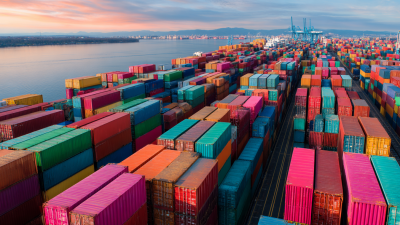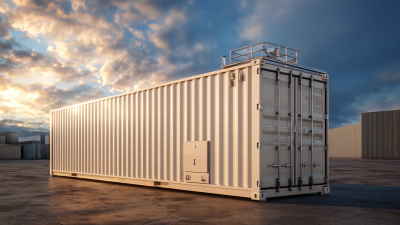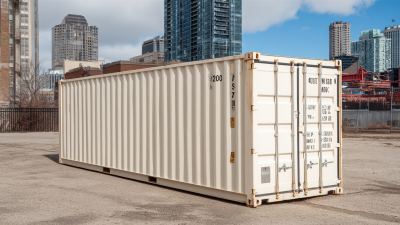Understanding the Impact of Shipping Container Sizes on Global Trade Efficiency
In the realm of global trade, the dimensions of shipping containers play a pivotal role in determining efficiency and effectiveness in logistics. Understanding the impact of shipping container sizes is essential for businesses and policymakers alike, as these standardized units facilitate the transportation of goods across vast distances. The choice of container size not only influences shipping costs but also affects loading and unloading times at ports, cargo storage optimization, and overall supply chain fluidity.

As global trade continues to expand, the logistics industry faces the challenge of balancing container sizes with the diverse needs of various markets and goods. By exploring the relationship between shipping container sizes and trade efficiency, we can gain valuable insights that inform shipping practices and ultimately enhance the flow of products around the world.
Overview of Shipping Container Sizes in Global Trade
Shipping containers are crucial to global trade, and their sizes play a significant role in determining shipping efficiency. The most common container sizes are the 20-foot (TEU) and the 40-foot (FEU) containers. According to the World Shipping Council, over 90% of international trade is carried by sea, and these standard sizes help streamline operations in ports around the world. The standardized dimensions of containers facilitate easy stacking, loading, and unloading, which minimizes turnaround times and reduces costs.
In recent years, the demand for larger vessels has led to a trend towards bigger container sizes. Ultra-large container vessels (ULCVs) can carry upwards of 24,000 TEUs. According to a report from Alphaliner, the average capacity of container vessels has nearly doubled over the past decade, enabling shipping companies to achieve economies of scale. However, the reliance on larger container sizes also presents challenges, as ports must continually adapt their infrastructure to accommodate these giants. The interplay between container sizes and logistical efficiency is a key factor shaping the future of the shipping industry and global trade dynamics.
Understanding the Impact of Shipping Container Sizes on Global Trade Efficiency
| Container Type | Dimensions (ft) | Capacity (CBM) | Common Usage | Trade Routes |
|---|---|---|---|---|
| 20' Standard | 20 x 8 x 8.5 | 32 | General cargo, consumer goods | Asia to North America |
| 40' Standard | 40 x 8 x 8.5 | 67 | Bulk goods, large commodities | Europe to Asia |
| 40' High Cube | 40 x 8 x 9.5 | 76 | Furniture, machinery | North America to Europe |
| 45' High Cube | 45 x 8 x 9.5 | 85 | Textiles, electronics | Asia to Europe |
| 20' Reefer | 20 x 8 x 8.5 | 28 | Perishable goods, food | South America to North America |
Analyzing the Efficiency of Standardized Container Dimensions
Standardized container dimensions have revolutionized global trade efficiency, allowing for seamless intermodal transportation across various modes of logistics. According to a report by the International Maritime Organization (IMO), the introduction of the ISO standard dimensions in the 1960s has led to a staggering increase in container throughput at ports. For instance, in 2020, approximately 800 million TEUs (twenty-foot equivalent units) were handled globally, highlighting the critical role of standardized container sizes in facilitating international shipping.
The dimensions of a standard shipping container, primarily the 20-foot and 40-foot variations, streamline loading and unloading processes, reducing turnaround times at ports. The World Bank's Logistics Performance Index reveals that countries with efficient port operations can see better economic growth, with a direct correlation between containerization and economic output. A well-coordinated use of standardized containers minimizes handling times, reduces costs, and significantly lowers the risk of damage during transit, which is crucial for maintaining supply chain reliability.

Implications of Container Size on Shipping Costs and Time
The size of shipping containers plays a crucial role in determining shipping costs and transit times in global trade. Larger containers, such as the 40-foot variant, allow for higher volume transport, which can significantly reduce costs per unit for shippers. This efficiency arises from the reduced number of containers needed to transport the same quantity of goods, leading to economies of scale. Conversely, using smaller containers may result in increased handling fees and a higher cost per unit, which can ultimately affect retail pricing and profit margins.
Additionally, container size impacts shipping schedules and vessel capacity. Larger ships can accommodate more goods, which can enhance the frequency of shipments between major ports. However, these ships might face challenges in accessing smaller ports, leading to potential delays in delivery times for businesses relying on timely stock replenishment. Therefore, the interplay between container sizes and shipping logistics is critical, as it not only influences the cost structure of global trade but also affects the supply chain dynamics and overall market competitiveness.
Technological Innovations to Optimize Container Shipping
The efficiency of global trade relies heavily on the optimization of shipping container sizes and technological innovations that streamline operations. Recent reports indicate that the use of standardized container sizes has increased shipping efficiency by up to 30%, enabling carriers to maximize their cargo space and reduce transportation costs. Innovations such as automated container stacking and tracking systems are pivotal in further enhancing this efficiency. According to a study by McKinsey, implementing advanced technologies can help shipping companies save approximately $2.7 billion annually by decreasing port waiting times and improving fuel efficiency.
 Tips: To maximize the benefits of shipping container optimization, consider investing in smart container technology. This allows real-time tracking and monitoring of shipment conditions, reducing losses and improving supply chain transparency. Additionally, utilizing route optimization software can significantly cut down transit times and costs.
Tips: To maximize the benefits of shipping container optimization, consider investing in smart container technology. This allows real-time tracking and monitoring of shipment conditions, reducing losses and improving supply chain transparency. Additionally, utilizing route optimization software can significantly cut down transit times and costs.
Moreover, the rise of mega container ships, which can carry over 24,000 TEUs (twenty-foot equivalent units), highlights the importance of continuous innovation in containerization. As per the International Maritime Organization, these larger vessels produce 30% fewer emissions per ton of cargo than their smaller counterparts. Embracing such advancements not only reduces environmental impact but also improves the sustainability of global trade practices.
Tips: Stay informed about the latest advancements in container shipping technology through industry newsletters and webinars. Adopting new technologies early can provide a competitive edge in the rapidly evolving shipping landscape.
Case Studies: Impact of Container Sizes on Trade Routes and Logistics
The analysis of container sizes in relation to global trade routes reveals significant implications for logistics and efficiency. As global trade continues to evolve, particularly with the introduction of methodologies like the Self-Organizing Map (SOM) neural network for port clustering, understanding the function and performance of major ports is more critical than ever. This approach highlights how container sizes affect not only the flow of cargo but also the strategic alignment of shipping routes. The expected transportation of nearly 30 million twenty-foot equivalent units (TEU) across the Pacific in 2024 underscores the demand for optimized shipping capabilities.
Recent trends indicate that new shipping routes, such as regular container services along the Arctic, are reshaping traditional trade patterns. These developments, combined with geopolitical factors and trade tensions, further influence container shipping dynamics. The ongoing analysis of shipping alliances also demonstrates how collaborative efforts among companies can enhance route efficiencies and adapt to rising operational costs. As container sizes continue to expand and evolve, their impact on logistics will play a pivotal role in determining the future landscape of global trade.
Impact of Shipping Container Sizes on Global Trade Efficiency
This chart illustrates the average shipping cost per Twenty-foot Equivalent Unit (TEU) for different shipping container sizes. The data shows how container size affects overall shipping expenses, which can significantly influence global trade efficiency and logistics planning.
Related Posts
-

Exploring the Versatility of 40ft Containers in Modern Logistics Solutions
-

Understanding the Dimensions of Standard Shipping Containers for Your Next Project
-

Maximizing Space: Innovative Uses for Your 20 ft Shipping Container You Haven't Considered
-

Exploring the Benefits of 40 Ft Shipping Containers for Sustainable Storage Solutions
-

Unlocking Savings: The Ultimate Guide to Discount Shipping Containers for Your Next Project
-

Maximize Your Space with a 20 ft Storage Container for Home and Business Solutions


